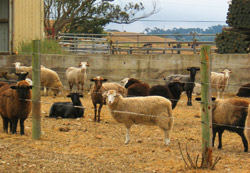Livestock Diversity
October 26, 2007
 CUESA Volunteer Adam Valainis wrote this week’s feature.
CUESA Volunteer Adam Valainis wrote this week’s feature.
Biodiversity refers to the variety and variability of animals, plants and microorganisms in an ecosystem. Genetic diversity (genetic variation among members of a species) and species diversity (a high number of different species in an ecosystem) are essential to the health of ecological systems, and are often used as a measure of their overall wellbeing. It is no surprise, then, that biological richness is just as important to agricultural ecosystems.
In September, the U.N. Food and Agriculture Organisation (FAO) brought the issue of agricultural biodiversity into sharp focus with the release of a report addressing global genetic diversity of livestock. “The State of the World’s Animal Genetic Resources” is alarming: the study found that over-reliance on certain breeds of livestock is causing rapid extinction of indigenous breeds – at a pace equivalent to roughly one breed per month.
Just as modern agriculture has contributed to the rapid decline of crop varieties (more than 90% of commercial vegetable varieties available in 1903 are now extinct), it has also led to the loss of many animal breeds. The global production of meat, milk, and eggs is largely based on a limited number of high-output, highly profitable breeds. As traditional production using locally adapted breeds is increasingly replaced by industrial and intensive methods of livestock production, these heritage breeds die out along with the unique genetic traits they possess.
Genetic erosion (the dwindling of genetic diversity within a breed as its numbers decline) can wipe out breeds that have valuable characteristics such as disease resistance or tolerance to variable climates, or that supply specialized products. Says Jose Esquinas-Alcazar of the FAO, “Maintaining animal genetic diversity will allow future generations to select stocks or develop new breeds to cope with emerging issues, such as climate change, diseases and changing socio-economic factors.” The report cited Uganda’s indigenous Ankole cattle, which are threatened with extinction as the Holstein-Friesian (a more prolific milk producer) displaces them. During a recent drought, many Ankole survived while the Holsteins were unable to walk long distances to reach the nearest water supply.
In America, the birthplace of many modern breeds and the epicenter of industrial agriculture, efforts to save heritage breeds are also burgeoning. Organizations like Slow Food and the American Livestock Breeds Conservancy are raising awareness about traditional breeds and the threats to their existence. Through promotion, research, and education, as well as technical support to breeders and farmers, these organizations seek to preserve traditional breeds for both their genetic worth and their contributions to gastronomy. Farmers and ranchers across the United States are saving these breeds by raising them, and eaters are contributing by demanding and enjoying their products.
With human population steadily on the rise and global climate change posing a significant threat, the preservation of agricultural biodiversity is more important than ever.
At the Ferry Plaza Farmers Market, look for heritage meats and animal products at Marin Sun Farms and The Fatted Calf.
Learn more:
FAO report
American Livestock Breeds Conservancy
Slow Food Ark of Taste
Marin Sun Farms
Fatted Calf
Topics: Animal welfare
